
The legionary movement reappeared in Romania immediately after the 1989 Revolution. The (neo)legionaries carried out their activities and promoted their ideas openly, without anyone stopping them. Veridica wrote about the activities carried out by the “old” legionnaires , the propaganda network they set up, and also about the way in which the authorities reacted to the emergence of the legionary movement in Romania.
The "old" legionnaires generally chose not to get involved in the political life of post-communist Romania. Some characters who associated with them, or who simply took over Legionnaire ideas and a cult for figures of the Movement, from Mircea Vulcănescu and Radu Gyr to Corneliu Zelea-Codreanu, wanted to do politics as well.
The neo-legionary parties – some formed by characters who had ties to the old communist Securitate or with figures from the Romanian Intelligence Service (SRI) – were not successful, but their leaders or members have reoriented themselves over time and are active today in the area of the so-called sovereignist movement as politicians, ideologists and propagandists.
We will now take a look at the political evolution of (Neo)Legionarism, from pocket political parties, such as those created by Marian Munteanu, to organizations like The New Right (Noua Dreaptă) – the connecting link between (Neo)Legionarism and sovereigntism – and politicians who frequently make the front page, such as George Simion, Călin Georgescu and Diana Șoșoacă.
Part II. From committed legionaries to sovereignists. How the promoters of legionary ideas came to the forefront of Romanian politics
For the Fatherland party, the legionnaires' first attempt to join the political mainstream
In 1993, the Simist legionnaires Nistor Chioreanu, Virgil Mateiaș and Nicolae Păun founded the “For the Fatherland” (Pentru Patrie) party, intended as a reincarnation of the “Everything for the Country” (Totul pentru țară) party, founded in the interwar period by Corneliu Zelea Codreanu and led by General Cantacuzino-Grănicerul. In fact, a few years later, in a press conference where legionary symbols were displayed, the leaders of "For the Fatherland" announced that they were changing the name of the party into “Everything for the Country”.
The members of the party included Ion Gavrilă Ogoranu, leader of the Anti-Communist Armed Resistance in the Făgăraș Mountains (vice-president and then president of the PPP until his death), actor Ernest Maftei, Mircea Nicolau, president of the "Prof. George Manu" Foundation, Nicolae Purcarea, a popular artist, prof. dr. Ion Brad, father Constantin Voicescu and father Dumitru Bălașa. In 2012, the Prosecutor's Office attached to the Bucharest Tribunal opened a dissolution process, on charges of fascism, anti-Semitism, xenophobia and activity contrary to the rule of law, based on GEO no. 31/2002, but in 2013 the court definitively ruled in favor of the legionnaires.
The party was finally outlawed in 2015, but not for its links to the Legionary Movement, but for failing to meet the target of a political party, namely at least 50,000 votes at the national level for the candidates proposed in any of the organized elections, and also for inactivity, which means it had no candidates for two successive parliamentary elections.
Between 1993 and 2002, the party published “Curierul Informativ” and “Buciumul” (2002 - 2009).
Connections: Marian Munteanu, Ceaușescu's Securitate, neo-legionnaires of the 1990s and (former) members of SRI
“The Movement for Romania” (MPR) was a nationalist-Christian group founded in 1992 by Marian Munteanu, the former leader of the students during the "University Square" phenomenon, following the legionary model – it was organized into "groups" similar to the legionary "nests" and had a senate, following the homonymous model established by Corneliu Zelea Codreanu in the 1930s. Vladimir Tismăneanu defined the MPR (1) as an organization that promoted national democracy or ethnocracy, based on the spiritual values promoted by Mihai Eminescu and Nae Ionescu, considered to be one of the ideologists of the Legionary Movement. The party was financed by Iosif Constantin Drăgan, a collaborator of the Ceaușescu regime but also a sympathizer of the legionnaires and an admirer of Marshal Antonescu (2).
Munteanu advocated for the "sectoral militarization" of Romania, with the goal of establishing at least a "bit of order in the administrative apparatus of the Romanian State" (3), which would have provided "logistical and organizational support from the military institution, for the proper functioning of the key ministries", as Munteanu and Dr. Corneliu Dida, member of the MPR Senate (later turned PSD deputy), explained during a press conference on January 22, 1994.
Munteanu also took a stand regarding the steps taken by some Jewish organizations in 1995 to grant material compensation to Jews who had suffered persecution in Romania, stating that "(…) we cannot overlook the obvious fact that the victims of repression and violence in Romania have always been Romanians and not national minorities (…)" (4).
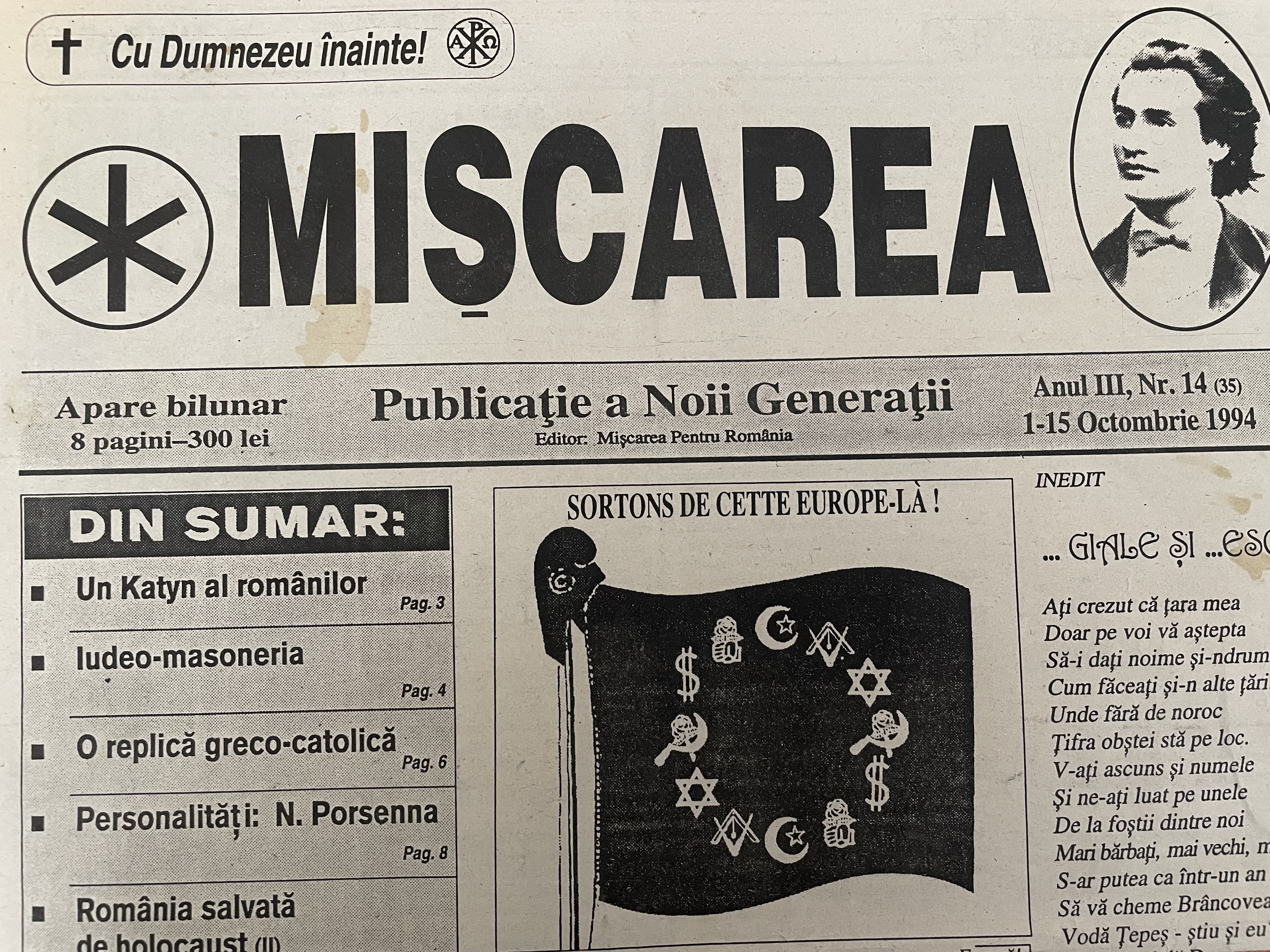
The magazine published by "The Movement for Romania" included texts of an anti-Semitic, anti-European nature, denying the Holocaust and attempting to rehabilitate some legionary figures. At the same time, the publication focused on Orthodoxy and promoted theses that today would be called "sovereignist".
In 1992, MPR participated in the elections, but failed to get even a single mandate. Subsequently, MPR organized numerous conferences in various cities across the country, especially in Bucharest and Târgu Mureș, and in 1996 the party disappeared.
Although MPR was clearly a legionary-inspired organization, followers of the Movement treated it with suspicion – for example, Virgil Maxim, from the George Manu Foundation, wrote in September 1995 that it was “a legion created by the neo-Communist government as a diversion” , and Răzvan Codrescu attributed MPR's failure to Marian Munteanu's infatuation and self-sufficiency, but also to the interference at the top of some former Securitate members or national-communists.
Also along these lines, Mircea Dimitriu stated that Munteanu's advisors included Navy Commander Radu Nicolae, a GRU agent, and Dumitru Dumitriu, a Securitate counterintelligence major.
In 1993, literary historian Dan Zamfirescu accused Marian Munteanu of having been a collaborator of the Securitate: “since Coja brought him to my house, for him to tell on me, for the Securitate, that I owned legionary literature. I mean, this was two years before the fall of Ceaușescu. And, after a few very provocative conversations, I said to him: Marian, let's be honest! What rank do you have, and I’ll tell you what rank I have. The man was absolutely stunned (…). Two weeks before the fall of Ceaușescu, I met Marian on the street, and he was scared: Sir, they caught me and they didn't know I was one of them, the guys from the other side had to come and save me… Then Măgureanu published his commitment and the figure.”(5). Later, in 2016, CNSAS (The National Council for Studying the Securitate Archives) would confirm that since March 28, 1988 to March 2, 1989, he had been spying on people for the Securitate, for money, under the cover name “Ioan”.
In 2000, the Romanian National Unity Party (PUNR), led by Valeriu Tabără and Mircea Druc, merged with the Romanian National Party, led by Virgil Măgureanu, forming the National Alliance. Marian Munteanu was initially proposed as the presidential candidate that year, but was excluded from the parliamentary lists, as a result of which Munteanu refused to register with the party. The alliance would soon dissolve itself, and its main leaders (Valeriu Tabără, Mircea Druc, Dorin Iacob, etc.) would join the Democratic Party led by Traian Băsescu.
The Group for Romania: anti-EU and NATO, pro-Russia and China, ties to sovereignists
In 2015, Munteanu established “The Group for Romania”, "a group of Romanian citizens aware of the spiritual wealth of the Romanian people. Aware of the creative sacrifice of the ancestors. Aware of the spiritual destiny of Romania, the garden of the Mother of God." Among the co-founders were economist Constantin Cojocaru, Cezar Avrămuță, known as the "Dacian flag-bearer", General Virgil Bălăceanu, former head of the Multinational Brigade South-East, Avram Fițiu, professor at the University of Agricultural Sciences and Veterinary Medicine in Cluj-Napoca, actor Florin Zamfirescu, who was also the spokesperson, journalist Miron Manega, Florin Colceag, the mathematics professor said to have trained Romanian geniuses, Dinu Criste, Viorel Gligor, Marian Ilie, Tudor Ionescu (The New Right) and Ion Pușcașu, who would be joined, among others, by historian Dinu Giurăscu, sociologist Ilie Bădescu and actor Dan Puric (former collaborator of the Securitate).
Most of them are seen as promoters of the sovereignist ideology, and the ideas they promote are also found in the speeches of some politicians in the sovereignist sphere, from Călin Georgescu to the leaders of AUR, S.O.S. Romania and POT. In fact, the "Dacian flag-bearer " stated that the group’s goal was to form a sovereignist pole alongside AUR and S.O.S. România , and some of the group's members were directly associated with AUR.
In 2024, the Group started issuing periodic communiqués in which, among other things, it would ask for the help of Russia and China to get rid of the state authorities, owned by the West, and withdraw from NATO.
Also in 2016, Marian Munteanu was designated by the National Liberal Party (PNL) as a candidate for mayor of the capital, but his candidacy was withdrawn after CNSAS revealed that he had been a collaborator of the Securitate. In the same year, Munteanu also founded the Our Alliance Movement, which would become the Our Alliance Romania party, with which he participated, unsuccessfully, in the parliamentary elections of that year, before dissolving it.
Also in 2018, Europlus warned about “the manipulation promoted by Daniel Dragomir and Marian Munteanu who advocate for Romania’s exit from the EU. The arguments they bring are in line with the manipulations promoted in Great Britain during the Brexit campaign" and which, at the time, were also pushed in parallel by Liviu Dragnea.
The New Right: Orthodoxy, joining the legionary doctrine, racism, xenophobia, anti-Semitism and homophobia
The New Right was officially founded in 2000, initially as an NGO, called the New Right Christian Forum, by Tudor Ionescu, who had decided to form his own group following disagreements with the For the Fatherland/Everything for the Country party which I wrote about earlier. Ionescu, who described his organization as a Christian-Orthodox one, became a supporter of the Legionary doctrine from the very beginning : “[I] don’t think anyone can ignore the existence of the interwar Legionary Movement and the doctrine it left behind. A doctrine that can be put to good use even now in 2001.”
The New Right managed to be very active locally from the beginning - by the end of 2005, the organization already had branches in almost half of the country's counties, as well as in the Republic of Moldova, Italy and Germany - but also to connect with extremist organizations abroad, participating, in 2003, in the establishment of the European National Front, which also included NPD (Germany), Bund Freier Jugend (Austria), England First (England), Bloc Identitaire (France), Mouvement Nation (Belgium), PNR (Portugal), Russkiy Obraz (Serbia), NOP (Poland), Slovenska Pospolitost (Slovakia), Pan-Ukrainian Union "Svoboda" La Falange (Spain), Forza Nouva (Italy) and Patriotiki Summahia (Greece); adding to those were the Bulgarian National Alliance (BNS), NSJ (Czech Republic), NSS (Latvia), Golden Dawn (Greece), Fiamma Tricolore (Italy) and National Alliance (USA).
Since the fall of 2000, The New Right has edited the homonymous magazine (6), which has stood out for its articles whose titles are suggestive of the group's homophobic, racist and anti-Semitic discourse: "Homosexuality today", "Stop the pagan invasion", "Political conspiracy", "Why are gypsies not Romanian", "Which Holocaust?", "The gypsy problem", "History is written by the victors".
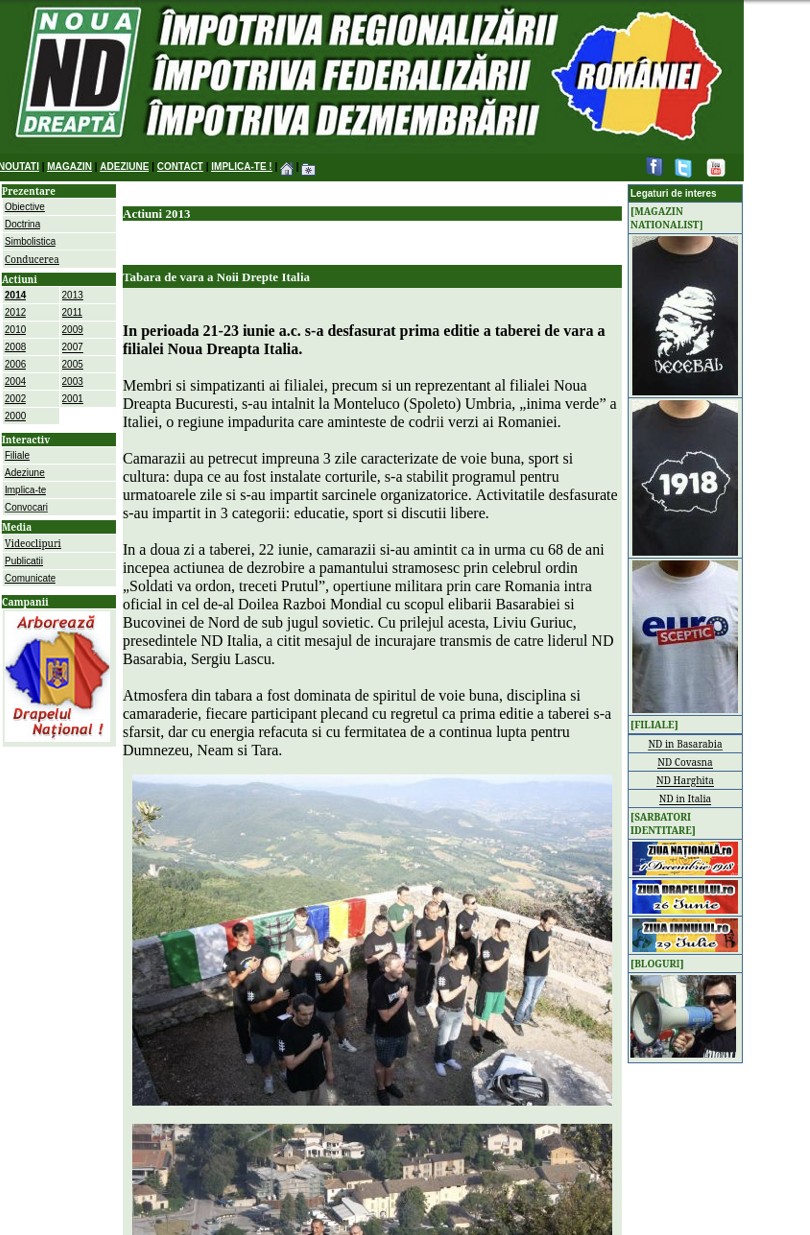
Article about an activity in Italy
The first actions of The New Right also date back to 2000: on June 30, it organized an anti-LGBT protest in front of the Senate, and on December 2, a march in memory of Codreanu, in Tâncăbești, the place where the legionary leader had been executed. The commemorations in Tâncăbești have become, in fact, a tradition of the (neo)legionnaires. In 2001, The New Right embraced a new cause, taking a stand against the concession of the mines in Roșia Montană, and two years later it opposed the American invasion of Iraq and organized, between March 27 and April 1, 2003, three pickets near the US embassy in Bucharest and a "march for peace", all under the title of "National Resistance Days".
The early 2000s also marked a series of participations of The New Right representatives in events organized by foreign extremists outside Romania – in Poland, the "Sword and Cross" camp organized by Narodowe Odrodzenie Polski (NOP), in the Czech Republic, in a demonstration organized in Prague by the Patriotic Front, the anniversary of the Spanish Falange and the "Celebration of Identity and Freedoms" in Versailles, on the occasion of which the European National Front was also established. 2004 records a new visit to Madrid, at the invitation of the Spanish Falange, and the commemoration of legionnaires Ion Moța and Vasile Marin, at Majadahonda, the place where the two were killed during the Spanish Civil War. In the same year, Claudiu Mihuțiu, the organization's external relations officer, went to Berlin, to attend the traditional NPD march dedicated to National Unity, and then to the NPD Summer University and Political Academy in Feldkirchen, Austria, organized by the Study Group for Democratic Politics and the Austrian Youth Union. Also in 2004, Tudor Ionescu and Goran Mrakici (head of the Timișoara branch of ND) participated in the meeting of nationalist organizations from Central and Eastern Europe, which took place in Slovakia (7).
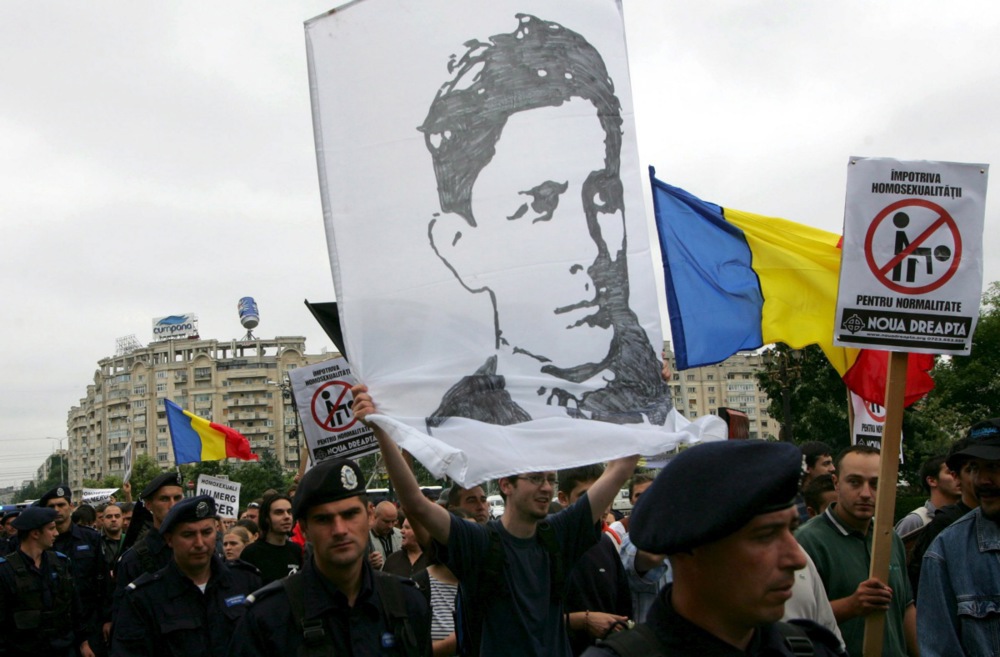
Corneliu Zelea-Codreanu’s portrait at an anti-LGBT protest organized by The New Right @EPA/ROBERT GHEMENT
The great cause of The New Right, however, remains, throughout all these years, the fight against the LGBT community, marked by a series of actions, the most visible being the counter-demonstrations at "pride" marches. The opposition to the LGBT community is also shared by the Romanian Orthodox Church, with which The New Right collaborated: in 2006, Tudor Ionescu participated in the press conference organized by the Romanian Patriarchate, on the topic of the LGBT parade, during which the vicar bishop Ciprian Câmpineanul explained the official BOR position: "a march, such as the one announced by homosexual organizations, is an attack on the morality of public life, on the sacred institution of the family and a danger to the formation of young generations, by exposing them to moral corruption", which Ionescu completed, stating that "the homosexual march violates good morals and abuses Romanians’ proverbial tolerance [...] such deviant or antisocial behaviors will always exist, but the solution does not consist in an effort of acceptance, but in one of combating and limiting these manifestations."
The New Right and sovereigntism: anti-EU theses and positions similar to those promoted by Russian propaganda
In 2006, The New Right launched the You will be left without a country campaign, in which numerous false anti-European theses and narratives were promoted: membership in the European Union means the loss of sovereignty, Romania's resources are being seized by external forces, European integration will lead to poverty and economic contraction, the European Union will impose censorship, Brussels will destroy the Romanian identity but also the Christian one, the EU will force Romania to bring in migrants from Asia and Africa who will destroy its ethnic structure, and so on: "Under the name of 'accession', an operation to annex Romania is practically underway [...] Romania will have an inferior status [...] because they need a ready-educated workforce, natural resources and markets [...] The EU is an atheist structure whose principles contradict the Christian religion [...] Romania will have no real decision-making power [...] For the average citizen, accession will bring a vertiginous increase in prices and the unemployment rate [...] In agriculture, unattainable standards will be imposed on peasants, and natural and competitive local products will be sabotaged by large food consortiums […] Most Western states will maintain their restrictions on Romanian workers. Even after accession, Romanians will not be able to work legally in all EU states […] the country will be invaded by immigrants […] In just a few years, they will be our colleagues and neighbors, their children will be classmates with ours, and we will be forced to respect their traditions and customs, to take down our Christian icons and no longer decorate the Christmas tree in public, so as not to offend them […] A new political ideology will be imposed, multiculturalism (dictatorship of minorities) […] national values will be considered hateful and will be destroyed. Romania's history will be rewritten […] Under the pretext of fighting terrorism, the press, radio, television and even the internet will be censored, telephone conversations and correspondence monitored (the Echelon system) and all contrary opinions will be banned.”
It is worth noting that, although all these theses have been refuted in the almost two decades since Romania became a member of the EU, most of them continue to be promoted as facts and circulate in sovereignist circles, both in Romania and in other countries of the European Union or with integration aspirations, such as the Republic of Moldova; there, such narratives play the role of scaremongering. At the same time, it is important that all these theses and narratives have also been promoted by the Kremlin propaganda at least since the period when Vladimir Putin became obsessed with “color revolutions” – in fact pro-European and pro-reform movements – and decided that the main opponents of his regime are civil society, the independent press and the values of liberal democracies.
The New Right also affirmed its anti-European ideology back in 2011, when it announced its opposition to Romania's accession to Schengen, the pretext being that, if Romania had joined, it would have led to a new Iron Curtain across the Prut - a thesis that was also refuted when Romania partially joined the Schengen area.
In 2014, Tudor Ionescu again took a stand that coincided with that promoted by Russian propaganda – he spoke out in favor of the separatist movements in Scotland, Catalonia, and Crimea, although a few years earlier, just like Russia, he had criticized separatism in Kosovo.
The migration of The New Right members to sovereignist parties
In 2015, The New Right turned into a party, which also led to a cleanup of its website (8). It changed its logo, removed any links to previously managed pages with legionary content, press releases, and generally anything that could have been used against the party – even its political program changed.
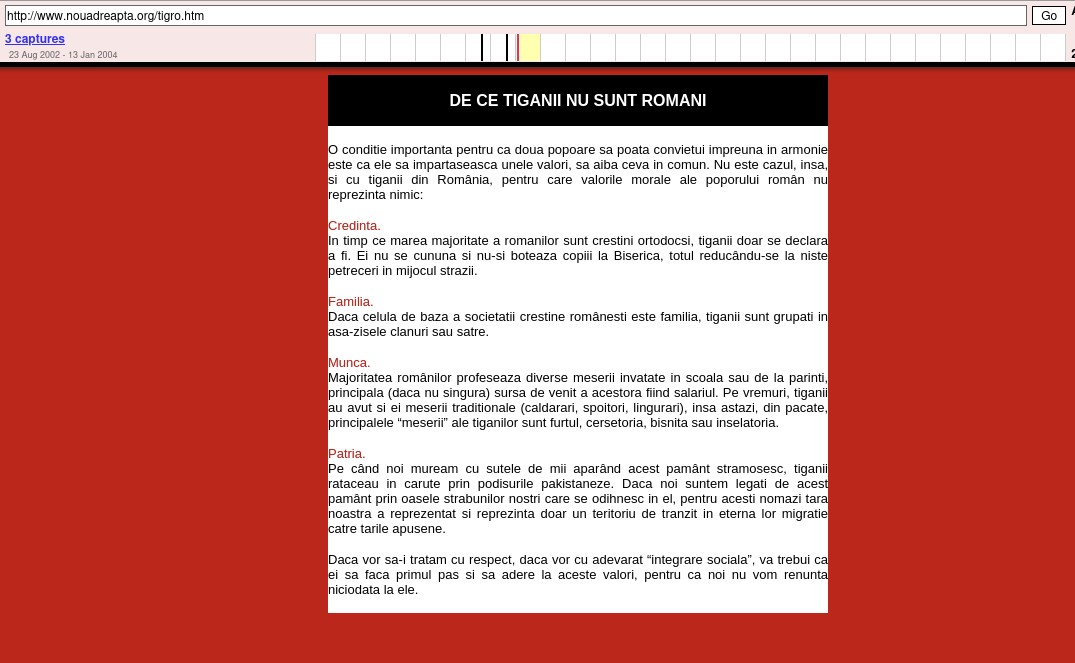
A racist article deleted from The New Right’s page, but recovered from the internet archives
The party, though, failed to convince the electorate, having mediocre performances in the elections: 4 local councilors in 2016 and 2 in 2020. However, this did not mean that the leaders and members of The New Right disappeared from politics; many continued their activity in sovereigntist parties or groups associated with them.
Tudor Ionescu has been an SOS deputy since 2024, and Tiberius Domozină ran on the SOS Olt lists for the Chamber of Deputies. Nicolae Iuruc, who also joined SOS, publicly broke away from the party because he did not receive a seat on the lists for the Senate at the Brăila branch.
Aurel Pascu, Adrian Jianu and Marius Danut Moldovan ran for the 2024 local elections on the AUR lists. Also with connections in the AUR area is Codrin Goia, who became known in 2022, when he tore the EU flag at a march for family. Codrin is also the leader of the Romanian Identity Community and an affiliate of the Cross Brotherhood, which has connections with George Simion’s Honor et Patria, NOI, Camarazii - ultras groups that also include employees of the Defense Ministry (MApN), Dan Grajdeanu’s Orthodox Brotherhood, but also with the "Gogu Puiu and the Outlaws of Dobrogea" association, headed by Eugen Sechila, an assumed legionnaire and associated with Călin Georgescu.
George Bara is one of the founders of napocanews.ro, a publication that leans towards the sovereignist zone – for example, it takes speeches by Călin Georgescu from Realitatea TV and offers a platform to Claudiu Târziu. In fact, Bara, along with another member of The New Right, Bogdan Stanciu, appears on Dugin’s famous list of friends of Russia in Romania. However, Zetta Cloud, an AI tech company founded by Bara, received the grand prize at PatriotFest 2022, where solutions "with potential impact in the field of national security and safety” were presented, which was organized with the support of institutions such as MApN, MAI, SRI, STS and SPP.
Some of those who tried to have a political career outside The New Right chose quite poorly. Constantin Nechita, Angel Popescu and Marin Naftalina ran unsuccessfully on the ANR/Marian Munteanu lists in the 2016 elections. Also running on the ANR lists was Ion Gebelescu, a.k.a. Swen Philippe Moritz, a.k.a. Swen Moritz Gebelescu, vice-president of The New Right who was said to be "the link between The New Right and extremist groups in Europe."
Nicolae Calotă, former vice-president and founder of the "Assault Brigade" band, left the New Right and joined Dan Diaconescu's PPDD, on behalf of which he ran for senator in 2014 (9).
Today's sovereignists and the legionnaires. From Călin Georgescu's association with neo(legionnaires), to the praising of some emblematic legionnaires by AUR leaders and Diana Șoșoacă
Legionary theses, the cult of emblematic figures of the movement (Corneliu Zelea-Codreanu, Moța and Marin, etc.), but also characters associated with neo-legionary groups after 1989, came to the forefront of Romanian politics with the growth of the sovereignist trend, which gave three parties to the Romanian parliament and two candidates, Călin Georgescu and George Simion, in the second round of the presidential elections.
The sovereignist figure most associated with legionary ideas seems to be Călin Georgescu. He has on several occasions praised leading legionary figures , including Corneliu Zelea-Codreanu. For some of the praises given to Corneliu Zelea-Codreanu and Marshal Ion Antonescu, the Prosecutor's Office took notice in 2022, but then dismissed the case; a new instance in which the state practically turned a blind eye (10).
According to Adina Marincea, a researcher with the Elie Wiesel National Institute for the study of the Holocaust in Romania, (neo)legionary organizations started supporting Călin Georgescu as early as 2015-2016 (11). These organizations include the Orthodox Brotherhood, the Gogu Puiu and the Outlaws of Dobrogea association, the Ogoranu foundation, the Group for Romania, etc. Călin Georgescu's connection with Eugen Sechila is also well known. Georgescu even sent his children to a camp organized by Sechila. According to prosecutors, Eugen Sechila was involved, along with Călin Georgescu and the mercenary Horațiu Potra, in devising the plan to destabilize Romania with the help of Potra’s mercenaries, , a plan that very much resembled a (neo)legionary rebellion.
Also linked to the name of Călin Georgescu – more precisely, his supporters – is the emergence of a phenomenon associated with the legionnaires from the interwar period, namely the blacklisting of journalists, people of culture, so-called Soros supporters and others.
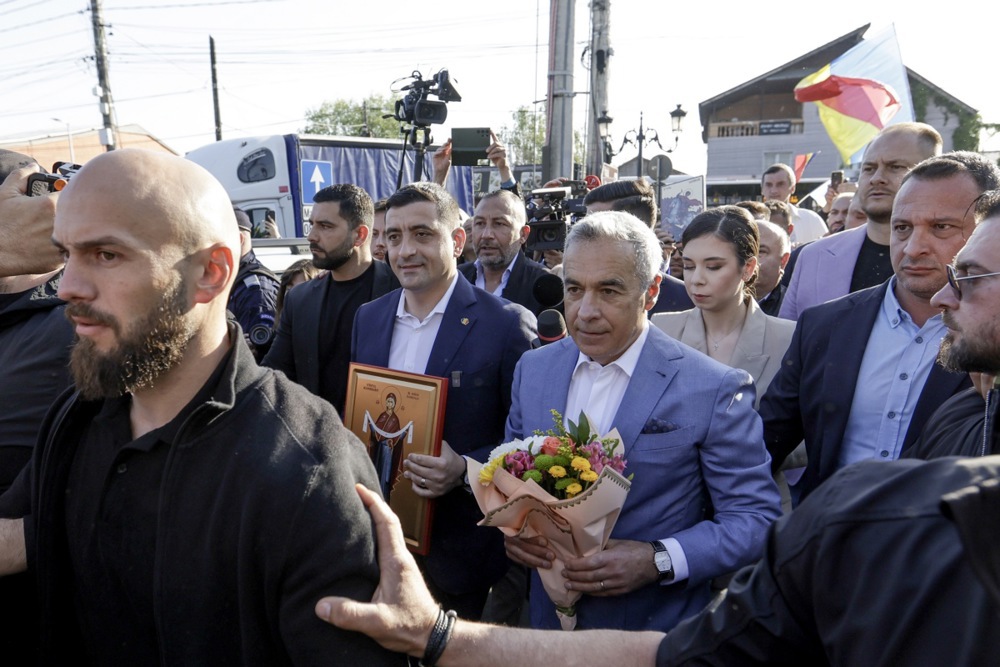
George Simion and Călin Georgescu, Mogoșoaia, 4 May 2025 @EPA-EFE/ROBERT GHEMENT
AUR leaders have also been associated with the Legionary movement and ideas. As we have already shown, Claudiu Târziu – who recently had a break with the party – was known to have connections with the leader of the “old” Legionaries, Șerban Suru. The same Târziu praised Legionary figures from the parliament rostrum, and so did Sorin Lavric who, like Târziu, was seen as one of AUR’s ideologues.
As for George Simion, the Romanian press noted similarities between his wedding and that of Corneliu Zelea-Codreanu, the latter being described by the "Captain" himself in his book "For Legionnaires". As history is also marked by coincidences, Codreanu's wedding took place in Focșani, where George Simion would be born a few decades later.
Simion's relationship with the legionary movement, however, is not just a matter of mimetism. An investigation by Info Sud-Est și Dobrogea Live partially attributes the success that the sovereignists and their presidential candidates, Călin Georgescu and George Simion, had in Dobrogea to the neo-legionary movement in this region of Romania. George Simion appears in recordings from events with a legionary touch. In this context one can also see the connection between Simion and the Archbishop of Tomis, Teodosie, associated with the neo-legionary movement in Dobrogea. Simion is also supported by Eugen Sechilă's mother-in-law, Zoe Rădulescu, who is the daughter of legionnaire Gogu Puiu.
Finally, Diana Șoșoacă, the leader of S.O.S. Romania, has voiced her admiration for Corneliu Zelea Codreanu on numerous occasions. Even the prosecutor’s office took notice of the statement , with a clear anti-Semitic content, that Șoșoacă made when the Constitutional Court rejected her candidacy for the 2024 presidential elections. The same Șoșoacă participated, just one day before the parliamentary elections on December 1, in a service commemorating Corneliu Zelea-Codreanu in the Tâncăbești forest . And it was also Șoșoacă who wrote Codreanu's name on the ballot paper she received to cast her vote in the presidential elections on May 4, 2025.
More than eighty years after his death, the Captain and his comrades continue to be "present!" in Romania.
Notes:
(1) Vladimir TISMĂNEANU, "The Ghosts of Salvation. Democracy, Nationalism and Myth in Post-Communist Europe", Translation by Magda Teodorescu, Afterword by M. Steven Fish, Polirom Publishing House, Iași, 1999, pp. 103-104
(2) Iosif Constantin Drăgan was also a notorious protochronist, famous for financing the gigantic bas-relief of Decebalus, carved into a rock on the banks of the Danube. After the Revolution, he amassed a huge fortune – he is said to have been the first Romanian billionaire. Historian Mădălin Hodor also wrote that Drăgan was one of the agents of influence of Ceaușescu's Securitate . It is also believed that Drăgan financed the newspaper România Mare, run by Corneliu Vadim Tudor; see in this regard Katherine Verdery, National Ideology under Socialism. Identity and Cultural Politics in Ceaușescu's România, University of California Press, 1991, p. 317.
(3) Marian MUNTEANU, "The Underground Struggle", in Mișcarea (The Movement), Year III, No. 3 (24), 1-15 Feb. 1994, p. 1.
(4) Marian MUNTEANU, "Communiqué regarding the claims of some Jewish organizations", in Mișcarea, Year III, No. 10 (31), June 1994.
(5) C. STĂNESCU, Lelia MUNTEANU, "Conversation with Dan Zamfirescu", in Adevărul literar și artistic, May 9, 1993.
(6) Other magazines associated with the New Right were Militant (Timișoara), Student! (Bucharest, Timișoara and Iași) or Spada (Chisinau).
(7) The New Right's appetite for international collaborations goes beyond camps and commemorations. In 2005, the New Right produced the compilation "Present!" , an album to which RAC, Oi, Punk, Thrash bands, etc., all with extremist messages, from countries such as Romania, Germany, Sweden, the Netherlands, the United States, Argentina, etc. contributed. The album cover features emblematic figures of the Legionary Movement. In fact, Tudor Ionescu was the bassist in the nationalist rock band "Brigada de asalt" (The Assault Brigade) , which appeared in the same period, and whose first album was entitled "A Nationalist Romania ". The band's songs can still be found on YouTube, some under the title Brigada 2. Also in the area of adjacent activities, a nationalist store was set up, where legionary, Orthodox and conspiracy literature, badges, T-shirts, caps, etc. could be purchased; and The New Right Radio for “promoting Romanian folk music, patriotic songs and identity rock.” Grigore Lese, Mugur Vasiliu (The Romanian Association for Culture and Orthodoxy), Razvan Codrescu (The “Christiana” Medical-Christian Association) and ethnologist Costin Nicolescu also took positions at the event.
(8) In addition to nouadreapta.org , there are also nouadreapta.ro, .com and .info, .it, nouadreaptaitalia.org, nouadreapta-ms.info and .md. The .org domain is linked to antimanelepentruRomânia.blogspot, karazbijnitza.blogspot.com, mnp-argentina.blogspot.com, pop-marius-claudiu.blogspot.com , magazin-nationalist.net, a-treia-cale.blogpot.com and there are two backlinks to tribuna-basarabiei.ro and craisorulmuntilor.ro.
As for nouadreapta.md, it is hosted on SmartApe servers in Russia, from which the Russian cybercrime group FIN7 operated .
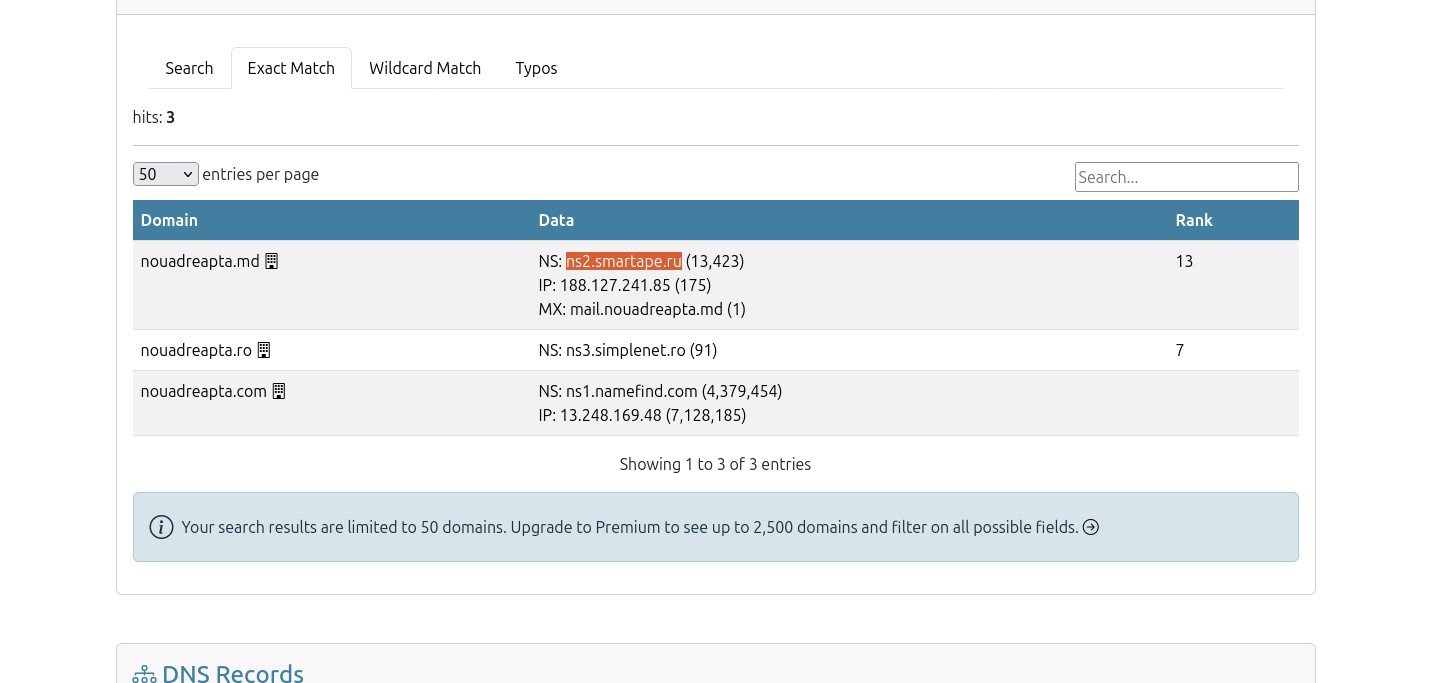
(9) Other figures from The New Right sphere have also come to the public's attention. Mihai Rapcea, involved in the efforts to establish The New Right party, is a lawyer and, according to his CV, graduated from a specialized course in foreign policy and diplomacy in 2013 at the Romanian Diplomatic Institute. He was a MISA lawyer and close to Gregorian Bivolaru, as well as Dan Diaconescu's lawyer in the case in which he was accused of blackmail. Rapcea is also a fan of Diana Șoșoacă, whom he described in March as " a spontaneous creature " on a show with Dan Diaconescu and the "Dacian flag-bearer".
Alexandru Gheorghe, who stood out in 2012, during the pro-Raed Arafat protests, when he was a lieutenant of the 71st Air Flotilla in Câmpia Turzii , at the department for the protection of classified documents , left the unit to chant against the then president, Traian Basescu.
Adrian Pal, former head of the internet department, was convicted in 2014 for child pornography after allegedly filming children from the "Sfântul Stelian" educational center.
(10) Even before Georgescu surprised the authorities and became an overnight TikTok star, another “star” on social media was Corneliu Zelea Codreanu . This phenomenon was also ignored by the authorities.
(11) The Romanian press has also raised a number of question marks regarding the possible association of Călin Georgescu with the former communist Securitate (and the examples of Marian Munteanu, Iosif Constantin Drăgan and many others show that such a scenario is plausible). Read here about Georgescu's possible connection with Russia via the former Directorate of Foreign Information (DIE) and the Caraman network . You can find out more about the (former) SRI, DGIA, MapN and police officers around Georgescu here . Finally, there have also been reports about Călin Georgescu's association with Mircea Malița , a former high-ranking official during the Ceaușescu regime and, later, a member of the Club of Rome, to whose image Călin Georgescu also sought to associate himself.
See also on Veridica Part I: The “old” legionnaires and the Romanian state’s tolerance towards the far right


